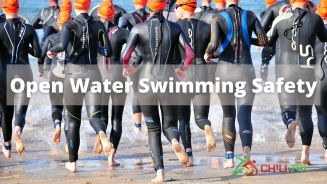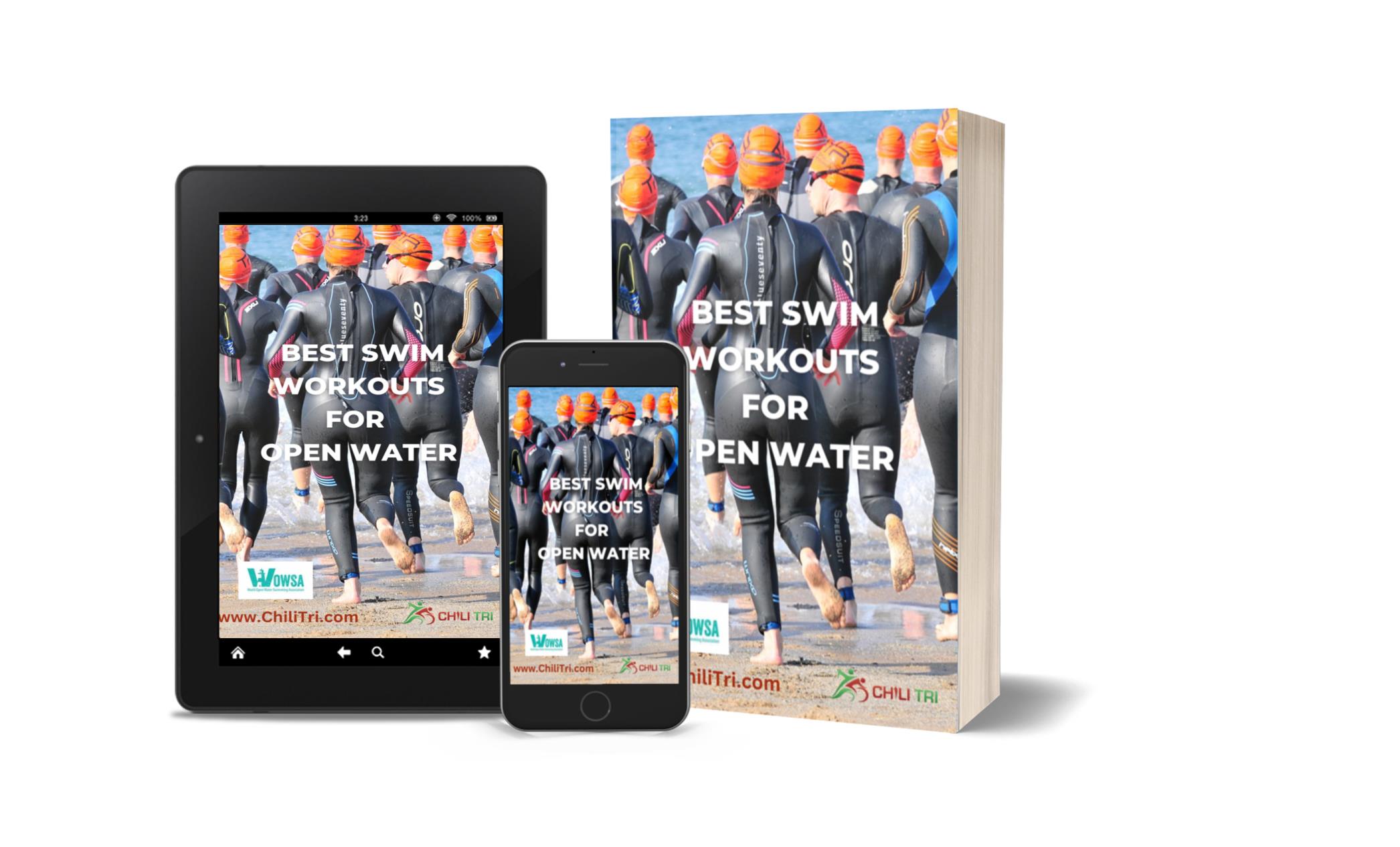Open Water Swimming Safety Guide: Key Tips to Protect Yourself and Swim with Confidence
 Karen Parnell
December 04, 2022
Karen Parnell
December 04, 2022
Open Water Swimming Safety Guide: Key Tips to Protect Yourself and Swim with Confidence
Open water swimming is one of the most rewarding experiences you can have in life. You get to explore the open waters, share your love of swimming with fellow swimmers and just see what's out there.
Not only is swimming incredibly beneficial for your physical and mental wellbeing, energy levels, and pain management, but gliding through an ocean, lake, or river water can make you feel at one with nature. But like any activity or sport, open water swimming can also be dangerous if not done properly.
So whether your are simply enjoy open water swimming with friend or training for an open water event here are some safety tips and considerations for open water swimmers, including the right equipment and gear to have on hand to increase your safety.
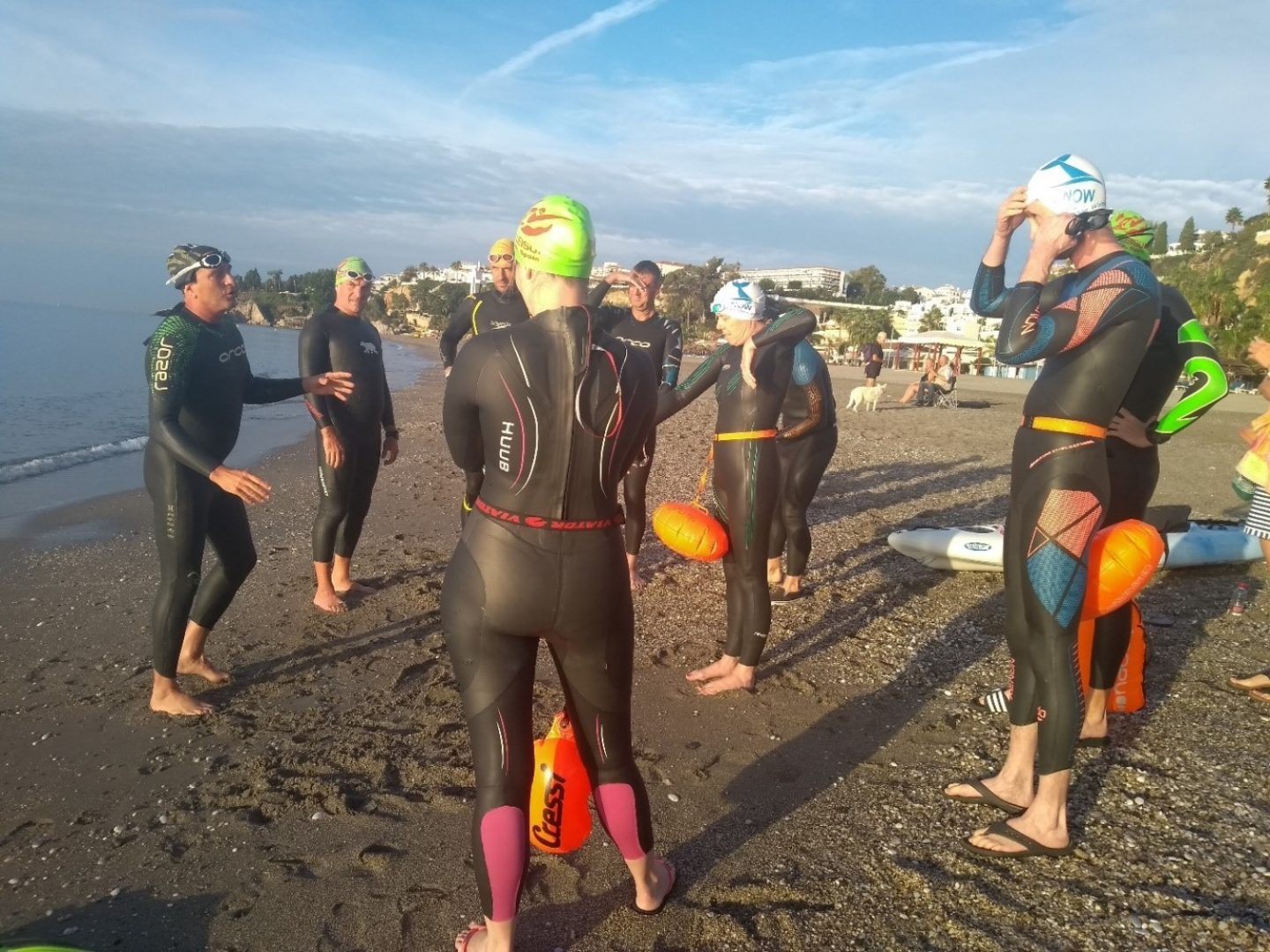
Safety briefing before swimming at a ChiliTri swimming camp
Get your FREE Open Water Swimming Sessions E-Book
Is it safe to swim in open water?
Swimming in open water can be safe; however, there are several risk factors and dangers associated with open water swimming that you don’t have to deal with when pool swimming. Adequately preparing yourself and others for your swim and being aware of potential dangers and how to avoid them can increase the safety of swimming in open water.
What are the dangers of swimming in open water?
Drowning is the primary danger associated with open water swimming. In fact, 79% of all drownings occur in open water. Swimmers in open water risk becoming fatigued, experiencing a cramp, getting swept away by a current or riptide, and much more, which can result in drowning. Lifeguards are not typically present at open bodies of water, so professional assistance is not immediately available in a time of need.
Swimmers also risk injury while swimming in open water from floating objects or debris, other swimmers, marine animals, or watercraft like boats or kayaks. Water temperature and depth are also much different from a swimming pool. Open water is colder, which can cause hypothermia, cold water shock, or after-drop if swimmers are not careful or wearing a wetsuit. After-drop refers to the decline in your core body temperature after you have got out of the water. When you swim in cool water the body cleverly tries to protect vital organs by reducing blood flow to the skin and limbs. Thus, the core stays warm while the skin, arms and legs cool down.
Many open bodies of water also pose a risk of infection. Open water is full of bacteria, so understanding when the best time to go to avoid infection and stay safe is critical.
Download your FREE open water swimming workouts book.
Open water swimming safety tips
1. Never Swim Alone
Always swim with a buddy swimmer, buddy in a kayak or on a SUP or have a shore spotter or lifeguard to keep an eye on you. Tie a whistle to your tow float so you can raise the alarm if you or your buddies get into trouble.
2. Be aware of the water quality
Checking the quality of the water you plan to swim in will help you avoid things like swimmer’s itch, infections, parasites, bacteria, and more. Municipalities or beach owner-operators regularly test many bodies of water and post results on designated local websites.
There is a sunscreen called Safe Sea which helps protect against swimmer’s itch and jelly fish stings.
If you’re swimming in water that doesn’t have the highest quality, consider using earplugs, nose plugs, goggles, and more to protect yourself from harm. Always avoid swallowing water, swimming with open cuts, swimming if you’re experiencing digestive issues, or jumping in the water 48 hours after significant rainfall. Shower directly after your swim and wash your hands before handling food.
3. Understand your surroundings and weather forecast
Talk to local swimmers, the lifeguard and online resources or Apps that detail currents, conditions and have web cams to understand where you are going to swim. Check the weather forecast and never swim if there is a chance of a thunderstorm.
In Spain we have an App called El Tiempo and it shows the weather, wave, and water temperature forecast.
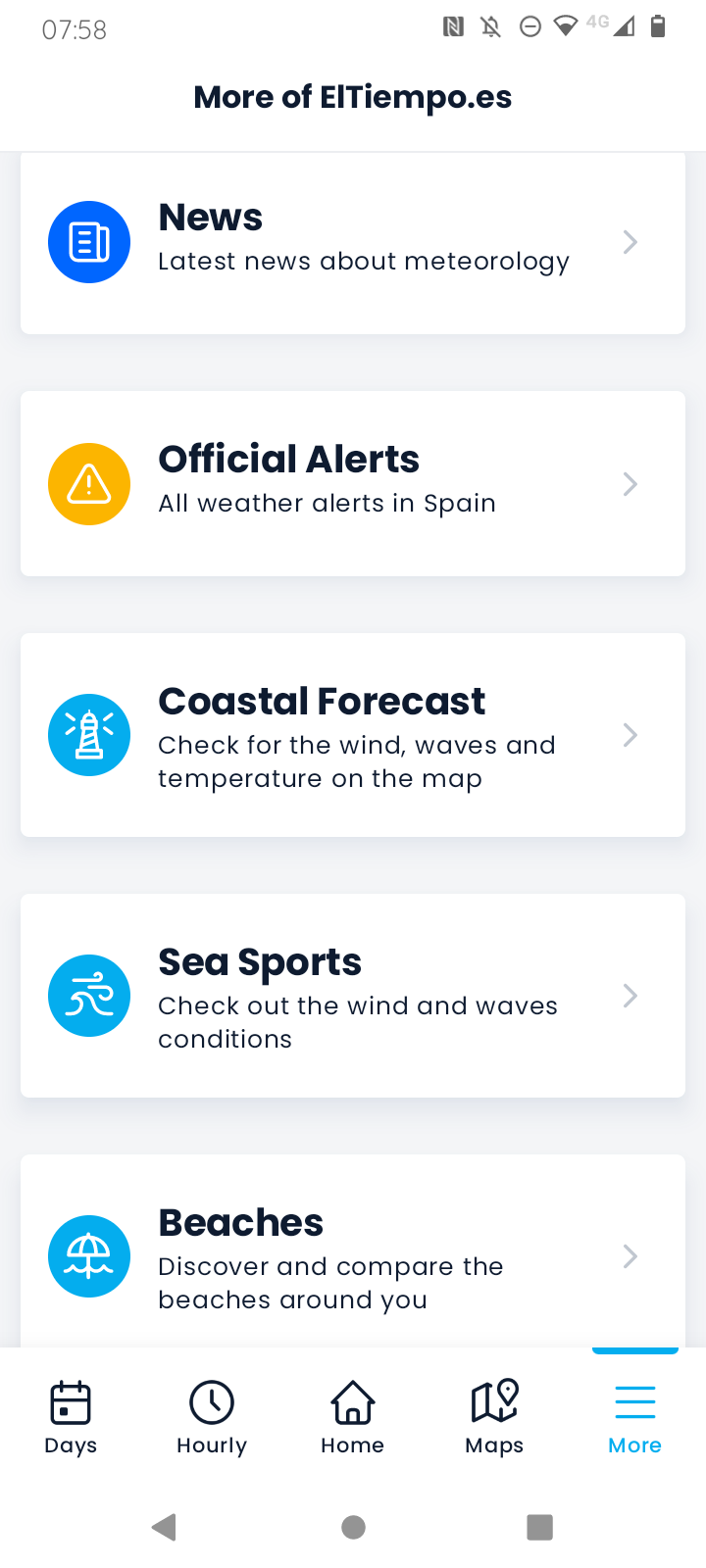
Get your FREE Open Water Swimming Sessions E-Book
4. Leave a trip plan
If you plan to swim without a swim buddy, let someone know where you’re going and when you’ll be back. Send them a message before you get into the water, then another one after you get out to let them know you’re safe.
Download your FREE open water swimming workouts book.
5. Be prepared in case of emergency
Emergencies are unexpected events (like fatigue, cramps, heat exhaustion, cardiac incidents, etc.) that require immediate action. These can all be life-threatening in open water.
It’s difficult to foresee an emergency but being prepared for one takes minimal effort and could save lives! Investing in swim gear such as a whistle and an emergency flotation device is a wise decision. There is a device Called Restube which is a small device you wear around your waist that you can inflate into a safety buoy in an emergency. In an emergency, above all else, try to stay calm while assessing your next move. If you do get into difficulty lay on your back and float in a star shape which will help calm you, get your breathing in check and expel less energy until help can get to you.
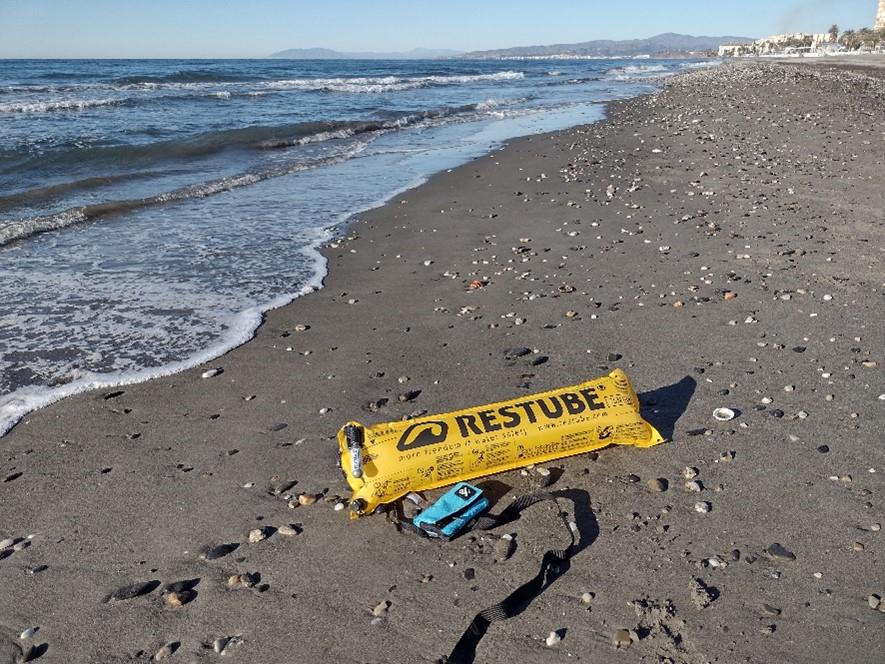
Get your FREE Open Water Swimming Sessions E-Book
6. Make yourself visible
Swimmers can easily go unnoticed in open water. Boaters, paddlers, and other swimmers may not be able to see someone swimming from their point of view.
Make yourself visible by wearing a bright swim cap and swimming with a tow float to stay safe against others on and in the water. Stop to look around every once in a while, for boat traffic if you’re swimming in an area with watercraft.
Top tip: look for a tow float with a waterproof area to carry your phone and keys, so you don’t have to leave them on land or in your car. You can also add waterproof lights to yourself or your tow float.
7. Consider hazards & marine life
Remember: you’re swimming in the wild when you’re in open water! These natural bodies of water aren’t controlled like your local pool. There are hazard risks that come with the territory, including logs, seaweed, debris, jelly fish and even sharks, depending on your location.
Always keep an eye out for these hazards. Take breaks to scan your surroundings and ensure the coast is clear. Most beaches will close temporarily after a shark sighting, so look for signs or check local websites for updates when approaching the beach.
8. Understand the dangers of rip currents and riptides
Rip currents and rip tides are significant threats to open water swimmers. It’s crucial to understand currents and what to do if you’re caught in one to escape and stay safe.
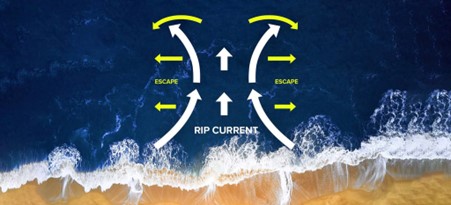
Rip currents are narrow currents of water flowing away from shore. They’re usually between 10 and 20 feet in width and occur primarily in surf zones.
Riptides are powerful currents that result from the tide pulling water out from an inlet. When the tide goes out and mixes with the ocean waves, it makes for a small area of hazardous, choppy water.
To avoid rip currents and riptides, look for them before jumping in and swim close to the shoreline. If you get caught in either a riptide or a rip current, you can escape by swimming perpendicular to the direction of the tide/current. Just remember to remain calm, don’t panic, indicate to a lifeguard if you’re in trouble, and swim parallel to the shore.
9. Know how far you’ve swam
It can be easy to underestimate the distance you wish to swim in open water. Setting a goal of swimming to a specific landmark (for example, an island or a log) may seem within reach. Still, once you start swimming, the estimated distance may be much further than you initially anticipated. You may also get lost in the flow of swimming and not realize you’ve gone much further than planned. If you don’t have enough energy to get back safely, this puts you at risk for a safe return to shore.
Consider investing in a waterproof GPS watch that displays your distance swam to solve this problem. That way, you can closely monitor your progress and ensure you don’t go farther than you feel comfortable.
10.Always have an exit point
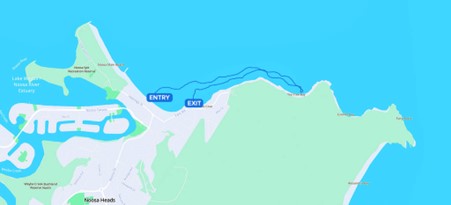
This tip applies to lake and river swimming. It’s easy to jump into the water for a swim, but muddy banks or sides can make it difficult to get out. Always make sure there’s a safe and accessible exit point for you to get out of the water.
11. Never swim at night or while intoxicated
This safety tip should go without saying, but night-time swimming and swimming while intoxicated are extremely dangerous! At night, visibility is limited, if not completely lost. This minimizes your ability to see hazards and threats around you. As for drinking and swimming, 31% of drownings are directly related to alcohol each year. The best solution is to swim sober during the day and save your cocktails for the evening!
Download your FREE open water swimming workouts book.
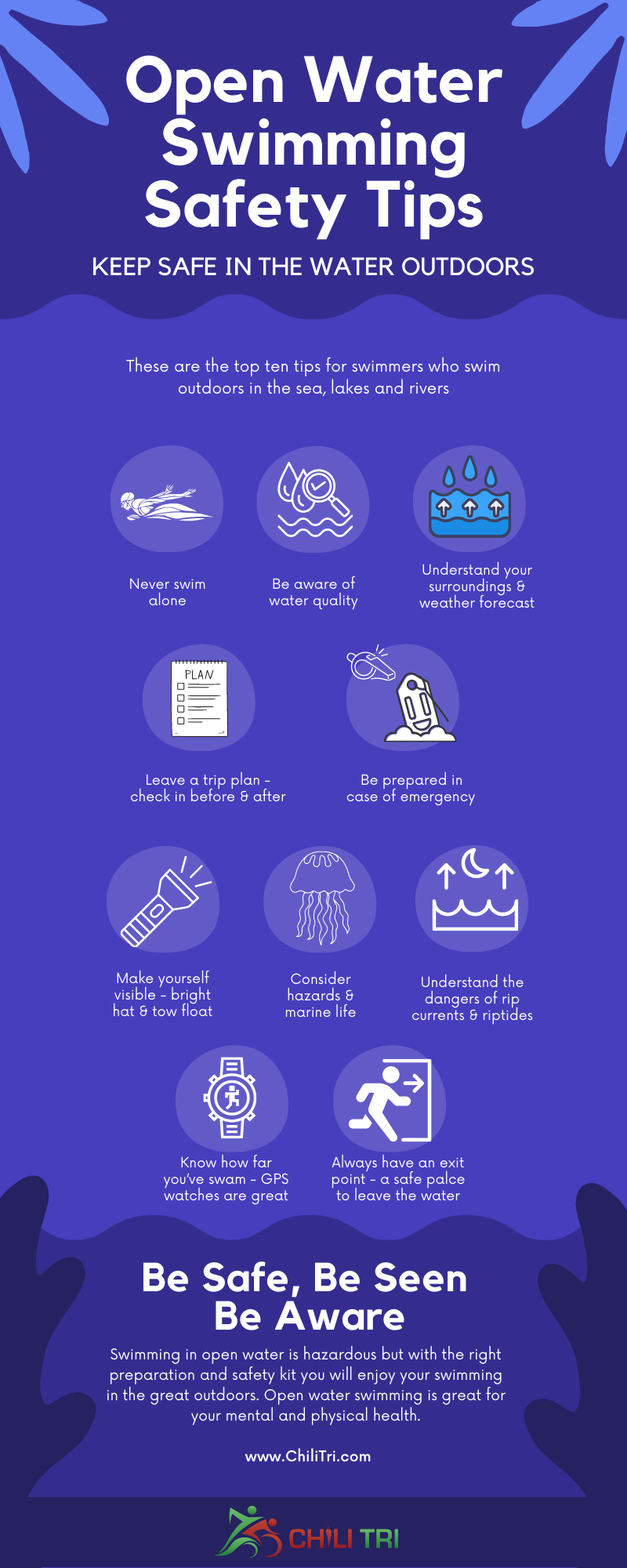
Get your FREE Open Water Swimming Sessions E-Book
I hope you have enjoyed this Blog. If you would like to work with me on your swim technique, I offer 121 swimming camps at my training centre in Southern Spain. I also offer 121 coaching and training plans on TrainingPeaks or FinalSurge.
If you would like to build your confidence in open water then one of our swimming clinics in Spain could be ideal for you.
Download your FREE open water swimming workouts book.
Swimming and Triathlon Training plans on TrainingPeaks.
Swimming and Triathlon Training plans on FinalSurge.
If you have any questions or would like a PDF of the safety tips infographic get in touch – karen.parnell@chilitri.com
Karen Parnell is a Level 3 British Triathlon and IRONMAN Certified Coach, 8020 Endurance Certified Coach, WOWSA Level 3 open water swimming coach and NASM Personal Trainer and Sports Technology Writer.
Karen is currently studying for an MSc in Sports Performance Coaching at the University of Stirling.
Need a training plan? I have plans on TrainingPeaks and FinalSurge:
I also coach a very small number of athletes one to one for all triathlon and multi-sport distances, open water swimming events and running races, email me for details and availability. Karen.parnell@chilitri.com
Get your FREE Guide to Running Speed and Technique
Get your FREE Swim Workouts for Triathletes E-book
Get your FREE Open Water Swimming Sessions E-Book
Karen Parnell – World Open Water Swimming Association profile.
FAQ Open water swimming safety
What is open water swimming?
Open water swimming refers to swimming in natural bodies of water such as lakes, rivers, or oceans, as opposed to swimming in a pool.
What are some safety considerations for open water swimming?
Open water swimming presents unique challenges compared to pool swimming. Here are some key safety considerations:
Swim with others: Whenever possible, swim with a buddy or in organized group swims. This provides safety in numbers and ensures there is someone to assist you in case of an emergency.
Be aware of water conditions: Check the weather forecast and be aware of water conditions before entering. Pay attention to factors such as water temperature, currents, tides, waves, and visibility.
Familiarize yourself with the area: If swimming in an unfamiliar location, take the time to understand the layout of the area, potential hazards, and entry/exit points. Know the depths, underwater structures, and any specific rules or regulations.
Wear a brightly coloured swim cap: A brightly coloured swim cap increases your visibility to other swimmers and boats. It makes it easier for others to spot you in the water, especially in crowded or busy areas.
Use a swim buoy or float: Consider using a swim buoy or float that attaches to your waist. This not only increases your visibility but also provides a safety floatation device and allows you to rest if needed.
Stay close to the shore: If you're new to open water swimming or not a confident swimmer, stick to swimming close to the shore or within designated swimming areas. This ensures that you have the option to quickly reach safety if necessary.
Practice sighting: Sighting is the technique of periodically lifting your head to look forward and ensure you're swimming in the right direction. Practicing this skill helps you maintain your course and prevents veering off track.
Be cautious of marine life: Depending on your location, be mindful of marine life such as jellyfish, sharks, or stingrays. Understand the risks associated with the local wildlife and take necessary precautions.
Consider a wetsuit: In colder water temperatures, wearing a wetsuit provides insulation and helps maintain body heat. It can also provide some additional buoyancy and protection.
Know your limits: Be honest with yourself about your swimming abilities and endurance. Avoid pushing beyond your comfort zone or attempting swims that exceed your skill level. Gradually build up your distance and experience in open water.
Remember, safety should always be the top priority when swimming in open water. Assess the conditions, be prepared, and use common sense to ensure an enjoyable and safe swimming experience.
Get you FREE open water swimming workouts book.
References
Open Water Swimming Safety: Rules and Gear – FORM (formswim.com)
lifesaving_drowning-2020_can_en_2020.pdf (lifesavingsociety.com)
Final Talking Points and Fact Sheet_041707.pdf (weather.gov)
#traithlontrainingplans #runningtrainingplans #swimmingtrainingplans #swimming #openwaterswimming #outdoorswimming

